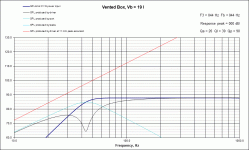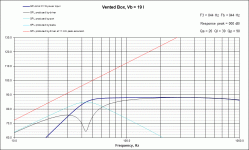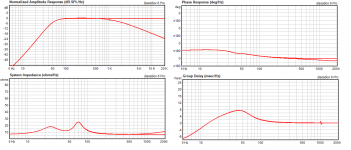Of what and at what frequencies, and with examples of the dramatic differences you claim in the behaviour of a conventional rear-loaded sealed or vented box, or a QW / TL with limited operating BW, with a normal moving coil driver. Say a Seas ER18RNX, or if you want a wideband unit, a Mark Audio Alpair 10P. Note: the enclosure / summed load across the enclosure's operating BW. Not what occurs above that.
Here's some comparisons from Unibox and Bass Box 6 Pro, both of which are well known and proven consistently reliable / accurate for well over a decade.
Driver assumed is a basic 6 1/2in midbass unit without any kind of Faraday shielding / symmetric drive / copper plating, and a moderate VC inductance; nominal 1KHz Le rating is 0.75mH, making it fairly average and therefore a reasonably representative. Box deliberately tuned to maximally flat for the sake of clarity. Result? As far as a standard, representative vented box goes, absolutely nothing to see here. You have the theoretical HF rolloff brought by the VC inductance which reaches an F3 at about 1.5KHz or thereabouts. Or, if you prefer, being pessimistic about 2 1/2 octaves above the operating window of the enclosure. My heart is not a-quiver. Especially since this is purely assuming electrical filter theory, not the actual response of the drive unit, which through resonant operation remains nominally flat (notwithstanding step loss & diffraction as relevant) out to c. 4KHz despite the rising VC impedance. Something to factor into the crossover design; the square root of jack practical relevance to the LF box loading.
What else? Well, there's the predictable minor shift in phase and GD, neither of which are of any significance within the operating BW of the box. If the latter increases, such as can be the case with horn loading, then a degree of attention is necessary, but this is an atypical condition since such enclosures are at best a minority compared to sealed, small-vent loads, and back-loaded bass horns are realistically limited to < c. 300Hz to prevent GD becoming excessive.
To be sure: if VC inductance is significantly raised -then it is something to consider. But this is hardly a universal condition; it is in fact rare, and mostly [though not exclusively] seen in / of relevance to pro and subwoofer design. So the question becomes: where are the massive issues claimed for the LF acoustical loading of most conventional loudspeaker enclosures, and why, if VC inductance is discounted for regular box modelling purposes with regular drive units, are the results now somehow inaccurate, despite millions of enclosures that have been designed in that way for decades accurately tracking the predicted behaviour? This is the point: a blanket statement that every single box model that does not account for VC inductance is useless, is simply not true.
Driver assumed is a basic 6 1/2in midbass unit without any kind of Faraday shielding / symmetric drive / copper plating, and a moderate VC inductance; nominal 1KHz Le rating is 0.75mH, making it fairly average and therefore a reasonably representative. Box deliberately tuned to maximally flat for the sake of clarity. Result? As far as a standard, representative vented box goes, absolutely nothing to see here. You have the theoretical HF rolloff brought by the VC inductance which reaches an F3 at about 1.5KHz or thereabouts. Or, if you prefer, being pessimistic about 2 1/2 octaves above the operating window of the enclosure. My heart is not a-quiver. Especially since this is purely assuming electrical filter theory, not the actual response of the drive unit, which through resonant operation remains nominally flat (notwithstanding step loss & diffraction as relevant) out to c. 4KHz despite the rising VC impedance. Something to factor into the crossover design; the square root of jack practical relevance to the LF box loading.
What else? Well, there's the predictable minor shift in phase and GD, neither of which are of any significance within the operating BW of the box. If the latter increases, such as can be the case with horn loading, then a degree of attention is necessary, but this is an atypical condition since such enclosures are at best a minority compared to sealed, small-vent loads, and back-loaded bass horns are realistically limited to < c. 300Hz to prevent GD becoming excessive.
To be sure: if VC inductance is significantly raised -then it is something to consider. But this is hardly a universal condition; it is in fact rare, and mostly [though not exclusively] seen in / of relevance to pro and subwoofer design. So the question becomes: where are the massive issues claimed for the LF acoustical loading of most conventional loudspeaker enclosures, and why, if VC inductance is discounted for regular box modelling purposes with regular drive units, are the results now somehow inaccurate, despite millions of enclosures that have been designed in that way for decades accurately tracking the predicted behaviour? This is the point: a blanket statement that every single box model that does not account for VC inductance is useless, is simply not true.
Attachments
Last edited:
Twaddle.
Agreed as presented, but losses due to inductance are akin to increasing box size to account for significant added series resistance [thermal power distortion] except that it's a variable resistance, so lossy inductance can normally be ignored in HIFI/HT apps unless it demands the driver
GM
So do you recommend I go with the calculated Vas, then?
WinISD allows inputting either measured specs or its T/S equivalent, so recommend inputting the former whenever available and let it calculate the missing specs.
Thiele Small parameters equations – How each one affects the others: Thiele Small parameters equations - How each one affects the others
GM
Funny that you mention TL's since I've been interested in them since the late '70's! I definitely need to check out Hornresp.
......and MJK's site to maximize its usefulness: Quarter Wavelength Loudspeaker Design
Re vented alignments for your drivers, they are suitable for MLTL loading, the most popular TL alignment around here.
GM
come on, le losses is real and you can stick your head in the sand if you want or take this in the simulation as well, your choice
old farts
Don't think it applies to Scott, but I resemble that remark!
Regardless, you apparently suffer from some sort of comprehension impairment since we both have agreed/stated it's real, just not a big deal for the average DIYer not intent on driving their speakers to [near] live levels for any length of time.
BTW/FWIW, historically, prosound has ignored it too, relying on the theoretically too small cab tuned too high to help protect it against over excursion.
GM
you are waving this off like this is not an issue, but it is, not so much for low inductance drivers as for higher, so, if it is something to consider is not up to you but to the diyer
that is it
Impact off the sofa
" [I]many years ago i bought tool's book 'sound reproduction', maybe it is time for me to read it [/I] "
You disappointed me .....
I think I can not stand it !
(although if I think about it, a sofa can not cause so many hearing problems ...)
Don't think it applies to Scott, but I resemble that remark!
Regardless, you apparently suffer from some sort of comprehension impairment since we both have agreed/stated it's real, just not a big deal for the average DIYer not intent on driving their speakers to [near] live levels for any length of time.
BTW/FWIW, historically, prosound has ignored it too, relying on the theoretically too small cab tuned too high to help protect it against over excursion.
GM
I absolutely agree with that phrase ....

Impact off the sofa
" [I]many years ago i bought tool's book 'sound reproduction', maybe it is time for me to read it [/I] "
You disappointed me .....
I think I can not stand it !
(although if I think about it, a sofa can not cause so many hearing problems ...)

are you aware that you have posted in the wrong thread? crazy
are you aware that you have posted in the wrong thread? crazy
Yes, I am very aware, take it with humor and open a more credible thread the next time .....
Regards
No it's not for LF alignment at small signal. That is after all what the T/S parms define.you are waving this off like this is not an issue,
Large signal is a completely different matter and the T/S only give a vague approximation of how the driver will actually perform at higher excursions.
The parms have to be input in the correct order if I recall correctly or the program doesn't like it.Btw, I've played with obsolete JBL drivers in WinISD (2225H, K140, E120, E140...). As their TSP's weren't in WinISD's stock list, I put in those from a table I've found at jblpro.com. WinISD complained incorrect driver parameters then. What's this?
Best regards!
I've used a ton of older JBL drivers in Unibox with no issues and results very close to the sims. T/S are usually from JBL.
I'm quite sure that I didn't puzzle the parameters, as they're named the same way both in WinISD and by JBL. I suspect the units might differ (imperial units from U.S. JBL, metric ones in WinISD?), but don't see so?
Best regards!
Edit: Here's the JBL table: http://www.google.com/url?sa=t&rct=j&q=&esrc=s&source=web&cd=4&cad=rja&uact=8&ved=2ahUKEwjCxK7bzInjAhXHJ1AKHUcmCnkQFjADegQIARAC&url=http%3A%2F%2Fwww.jblproservice.com%2Fpdf%2FThiele%2520Small%2520Parameters%2FTheile%2520Parameters.pdf&usg=AOvVaw3smWugFZIQE2CrUv_u174i
Best regards!
Edit: Here's the JBL table: http://www.google.com/url?sa=t&rct=j&q=&esrc=s&source=web&cd=4&cad=rja&uact=8&ved=2ahUKEwjCxK7bzInjAhXHJ1AKHUcmCnkQFjADegQIARAC&url=http%3A%2F%2Fwww.jblproservice.com%2Fpdf%2FThiele%2520Small%2520Parameters%2FTheile%2520Parameters.pdf&usg=AOvVaw3smWugFZIQE2CrUv_u174i
Last edited:
It's not a software issue per se; like pretty much any decent lumped element modelling software (Unibox, BB6Pro &c.) WinISD calculates parameters based on previous inputs. So, for e.g., if you enter Qe & Qm, but the Qt provided in the data sheet is not exactly as would be calculated from these will for whatever reason (many manufacturers may round to the nearest decimal or similar) then you will get a conflict. The solution in this case is not to enter Qt; use the software calculated value.
You'll often get similar issues / variations elsewhere, as T/S data provided by manufacturers are often individually averaged values over a batch or selection of samples, which don't necessarily match up when taken as a whole. As far as WinISD goes, I tend to favour entering Fs, Re, Qe, Qm, Sd, Xmax, Pe, Xlim [Xmech] if available, and either B*L or Vas, then let the software calculate the rest. Some software calculates even more from less data entered, and by and large, the results are consistenly accurate for design purposes assuming the baseline originals are OK.
You'll often get similar issues / variations elsewhere, as T/S data provided by manufacturers are often individually averaged values over a batch or selection of samples, which don't necessarily match up when taken as a whole. As far as WinISD goes, I tend to favour entering Fs, Re, Qe, Qm, Sd, Xmax, Pe, Xlim [Xmech] if available, and either B*L or Vas, then let the software calculate the rest. Some software calculates even more from less data entered, and by and large, the results are consistenly accurate for design purposes assuming the baseline originals are OK.
When I started using WinIsd (I was more intuitive than HR) it occurred to me to check the results of a JBL DIY development for a rather unconventional vintage speaker.
It is not in the list that was added by kay pirinha, it is the coaxial JBL LE14C.
Basically, it is an LE14A with the addition of an LE20 tweeter at its center, taking advantage of the generous diameter of the 4-inch voice coil.
I used the TS parameters contributed kindly by Bjorno. (See post 132)
One of the different parameters was that LE14C has a dust cover that acts as an extra spider, making the compliance higher.
But to my surprise, WinIsd accepted the loaded parameters and the result was practically the same as calculated by JBL engineers, same number of liters and same duct.
I think it's a very reliable software, maybe not complete enough, I think it does not calculate the inductance of the VC, for example.
Vintage JBL for subwofer
It is not in the list that was added by kay pirinha, it is the coaxial JBL LE14C.
Basically, it is an LE14A with the addition of an LE20 tweeter at its center, taking advantage of the generous diameter of the 4-inch voice coil.
I used the TS parameters contributed kindly by Bjorno. (See post 132)
One of the different parameters was that LE14C has a dust cover that acts as an extra spider, making the compliance higher.
But to my surprise, WinIsd accepted the loaded parameters and the result was practically the same as calculated by JBL engineers, same number of liters and same duct.
I think it's a very reliable software, maybe not complete enough, I think it does not calculate the inductance of the VC, for example.
Vintage JBL for subwofer
- Status
- This old topic is closed. If you want to reopen this topic, contact a moderator using the "Report Post" button.
- Home
- Loudspeakers
- Multi-Way
- How close is WinSD?



